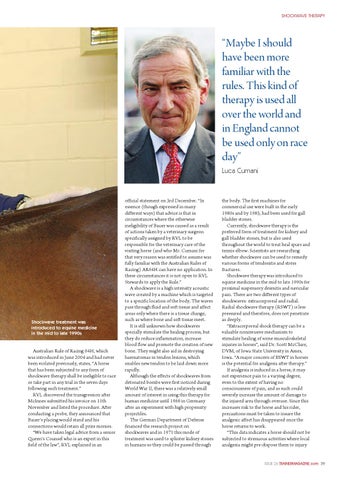SHOCKWAVE EURO.qxd:Jerkins feature.qxd
22/5/09
11:33
Page 2
SHOCKWAVE THERAPY
“Maybe I should have been more familiar with the rules. This kind of therapy is used all over the world and in England cannot be used only on race day” Luca Cumani
Shockwave treatment was introduced to equine medicine in the mid to late 1990s
Australian Rule of Racing 64H, which was introduced in June 2004 and had never been violated previously, states, “A horse that has been subjected to any form of shockwave therapy shall be ineligible to race or take part in any trial in the seven days following such treatment.” RVL discovered the transgression after McInnes submitted his invoice on 11th November and listed the procedure. After conducting a probe, they announced that Bauer’s placing would stand and his connections would retain all prize monies. “We have taken legal advice from a senior Queen’s Counsel who is an expert in this field of the law”, RVL explained in an
official statement on 3rd December. “In essence (though expressed in many different ways) that advice is that in circumstances where the otherwise ineligibility of Bauer was caused as a result of actions taken by a veterinary surgeon specifically assigned by RVL to be responsible for the veterinary care of the visiting horse (and who Mr. Cumani for that very reason was entitled to assume was fully familiar with the Australian Rules of Racing) AR64H can have no application. In these circumstances it is not open to RVL Stewards to apply the Rule.” A shockwave is a high intensity acoustic wave created by a machine which is targeted to a specific location of the body. The waves pass through fluid and soft tissue and affect areas only where there is a tissue change, such as where bone and soft tissue meet. It is still unknown how shockwaves specially stimulate the healing process, but they do reduce inflammation, increase blood flow and promote the creation of new bone. They might also aid in destroying haematomas in tendon lesions, which enables new tendon to be laid down more rapidly. Although the effects of shockwaves from detonated bombs were first noticed during World War II, there was a relatively small amount of interest in using this therapy for human medicine until 1966 in Germany after an experiment with high propensity projectiles. The German Department of Defense financed the research project on shockwaves and in 1971 this mode of treatment was used to splinter kidney stones in humans so they could be passed through
the body. The first machines for commercial use were built in the early 1980s and by 1985, had been used for gall bladder stones. Currently, shockwave therapy is the preferred form of treatment for kidney and gall bladder stones, but is also used throughout the world to treat heal spurs and tennis elbow. Scientists are researching whether shockwave can be used to remedy various forms of tendonitis and stress fractures. Shockwave therapy was introduced to equine medicine in the mid to late 1990s for proximal suspensory desmitis and navicular pain. There are two different types of shockwaves: extracorporeal and radial. Radial shockwave therapy (RSWT) is less pressured and therefore, does not penetrate as deeply. “Extracorporeal shock therapy can be a valuable noninvasive mechanism to stimulate healing of some musculoskeletal injuries in horses”, said Dr. Scott McClure, DVM, of Iowa State University in Ames, Iowa. “A major concern of ESWT in horses is the potential for analgesia after therapy.” If analgesia is induced in a horse, it may not experience pain to a varying degree, even to the extent of having no consciousness of pain, and as such could severely increase the amount of damage to the injured area through overuse. Since this increases risk to the horse and his rider, precautions must be taken to insure the analgesic affect has disappeared once the horse returns to work. “This data indicates a horse should not be subjected to strenuous activities where local analgesia might pre-dispose them to injury
ISSUE 26 TRAINERMAGAZINE.com 39
